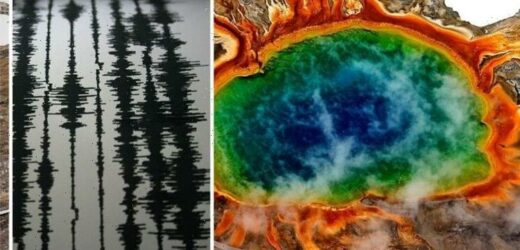Yellowstone supervolcano: Expert on ‘danger’ of Caldera in 2015
We use your sign-up to provide content in ways you’ve consented to and to improve our understanding of you. This may include adverts from us and 3rd parties based on our understanding. You can unsubscribe at any time. More info
Yellowstone, located in Wyoming, US, is one of 20 known ‘supervolcanoes’ — a volcano that has had an eruption with a Volcanic Explosivity Index of eight. It has erupted three times in the past 2.1 million years, with the most recent at least 1,000 times bigger than Mount St. Helens’ eruption that devastated America in 1980. Each of the last three eruptions formed calderas — large cauldron-like hollows that form upon the emptying of a magma chamber. Volcanoes sometimes empty their magma stores so quickly that the overlying land collapses into the emptied magma chamber, forming a depression.
The Yellowstone hotspot, which lies beneath the surface, is believed to have produced at least a dozen supereruptions in the past 16.5 million years, prompting intense research at the picturesque National Park.
Scientists continue to closely monitor Yellowstone for any signs that it is preparing to blow its top, but it is widely accepted that any eruption in the next 10,000 years is extremely unlikely.
This has not stopped fieldworkers studying the caldera, with some of their work explored during the Naked Science documentary, ‘Super Volcano’.
In the spring of 2003, scientists set to work after a series of strange events occured — geysers were bursting into life, new cracks in the ground appeared and satellite pictures revealed changes were happening beneath the surface.
The documentary’s narrator explained that all volcanoes give out warnings when they are preparing to erupt, and at Yellowstone this would trigger the “mother of all evacuations”.


He said: “The first sign of a Yellowstone eruption would probably be the ground rising.
“Just before Mount St. Helens erupted, the mountain bulged, growing five feet per day.
“A similar kind of uplift would be likely at Yellowstone. As magma deep below the surface of the earth rises, it splits the rocks above.
“In Yellowstone, it would probably lift the whole caldera, an area the size of Houston and Dallas, 10 feet or more into the air.”
He continued: “Weeks or even months before a Yellowstone supereruption, these warning signs would trigger the mother of all evacuations.

“The area 60 miles around the volcano would become a hazard zone.
“Officials would place on alert the surrounding region — up to 200 miles — readying people for a violent eruption.
“As people evacuated the area, geologists would look out for new warning signs that would tell them an eruption is imminent.”
Professor Bill McGuire, one of the world’s leading volcanologists, told the documentary that “swarms of earthquakes” would be seen as fresh magma moves into the system and breaks the rock above it.
Such earthquakes produce distinctive waveforms on seismographs as the crack of rocks fracturing creates a sharp rise that fades quickly.
DON’T MISS:
Ancient Egypt breakthrough as body could explain mummification origins [INSIGHT]
Archaeologists stunned at tool found near mammoth bones [DISCOVERY]
‘No technology’ could stop devastating Yellowstone eruption [EXPERT]

Long before an eruption, the hazard zone and surrounding area would be hit by these earthquakes.
Just before an eruption, the signal produced by the earthquakes would give way to a very different one — a long, continuous vibration.
Prof McGuire explained: “Now when magma has opened a space for itself, it will start to move through that.
“And as it moves through that fairly rapidly, it will start to vibrate the walls of the crack or the conduit.
“And that will give you a sort of rumbling signal.”

Called harmonic tremor, it sounds like the vibration of a large organ pipe, and is the final warning sign before an eruption.
Scientists and organisations have spent decades attempting to find solutions that might stop any future Yellowstone eruption.
NASA speculated the possibility of increasing the amount of water inside the volcano, aiming to extract heat from it and also reduce the risk of a pressure build-up.
Ultimately, this was considered both far too difficult and far too risky.
While some have suggested Yellowstone is ‘due’ to erupt, the apparent cycle of an eruption every 725,000 years means there is still about 100,000 years to go.
Even so, the United States Geological Survey said such speculation is meaningless since volcanic systems that have a supereruption typically do not have evenly spaced eruptions.
Likewise, if Yellowstone erupts again, there are no guarantees that it will be a large eruption.
The most recent lava flow occurred as Yellowstone 70,000 years ago, with a more violent eruption 174,000 years ago.
Source: Read Full Article


